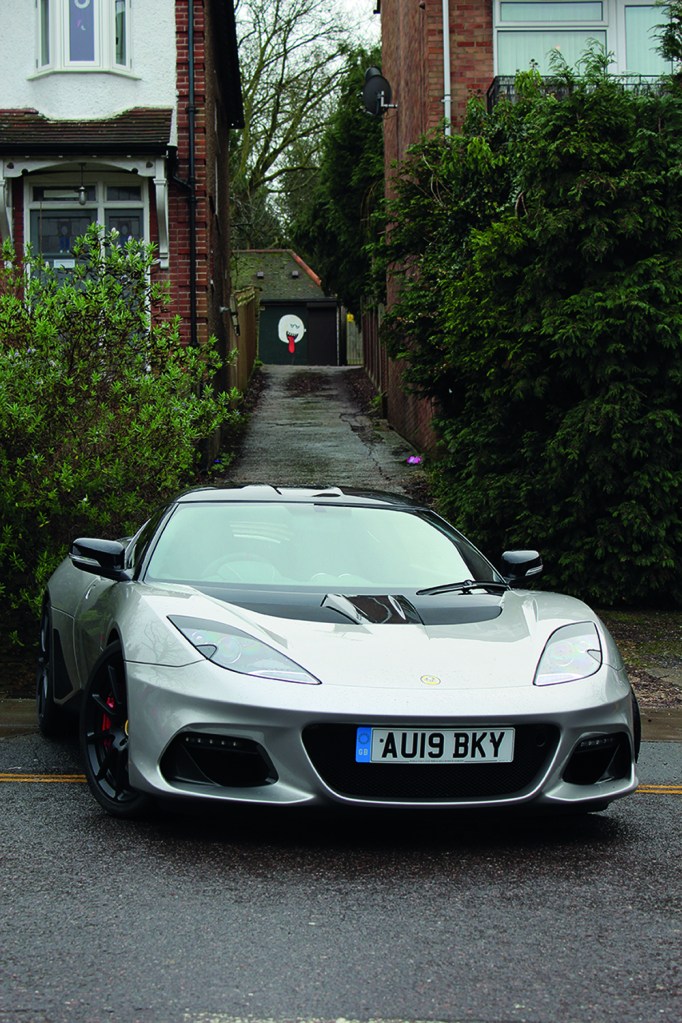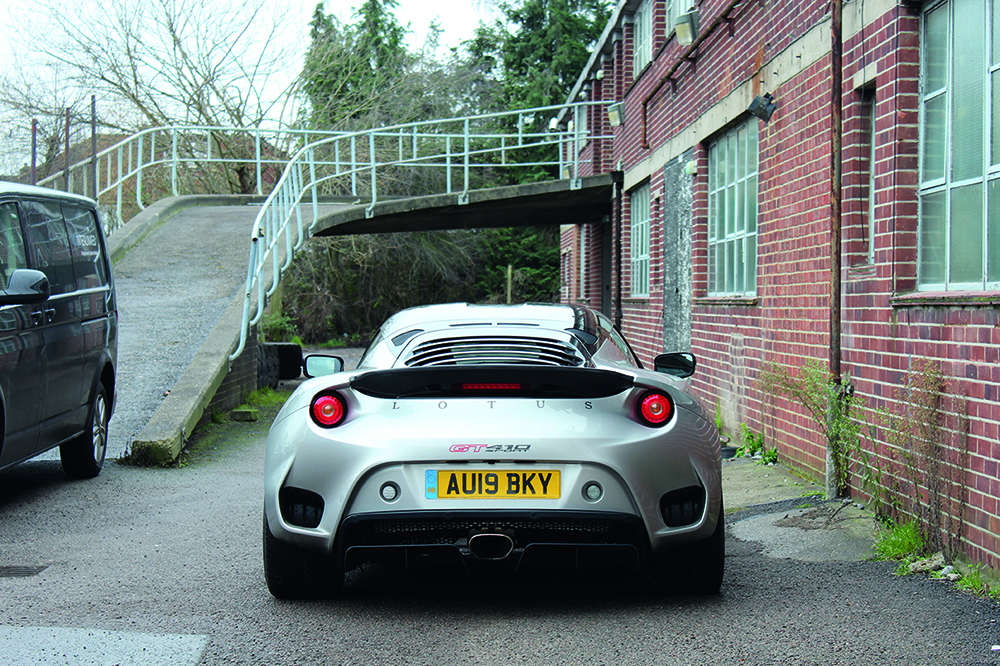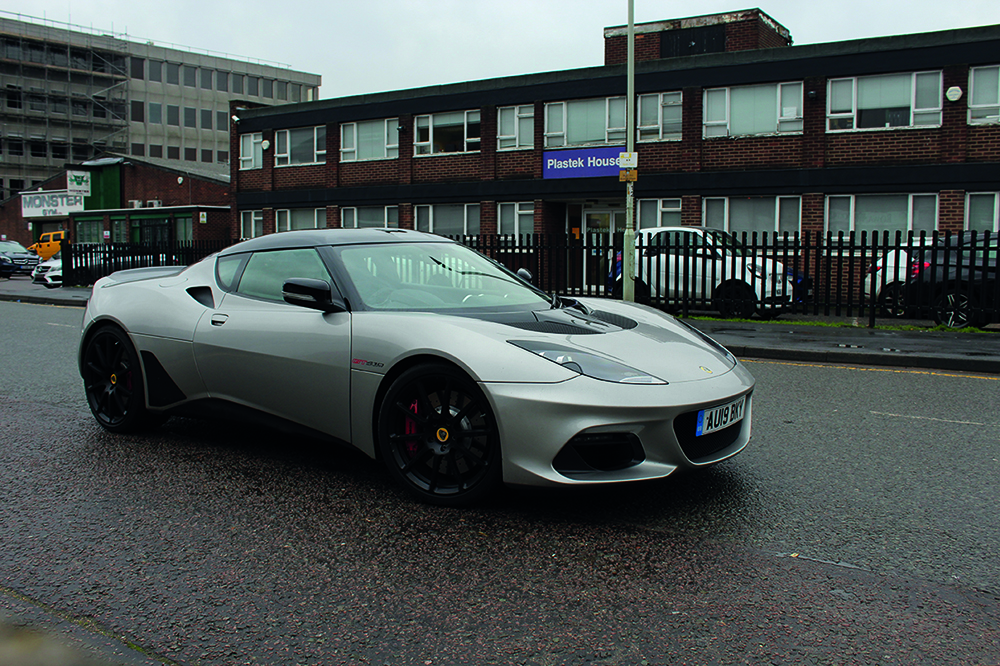This is an abridged version of the story first published in Absolute Lotus magazine in 2020
A trip around the M25 on a weekday morning wouldn’t usually be a cause for excitement, but as I sit in the driver’s seat of this Evora GT410 Sport I can tell this isn’t going to be a typical trip into London. It may have been just as slow as a typical city centre commute, but we were on a mission to trace the geographical history of this very car, and we had just a day to do it.
As a keen ‘carchaeologist,’ I was excited to see the sites from which this innovative marque grew from a group of mates building trials cars in their spare time to a world beating race and sports car concern. The first destination on my journey was to be the childhood home of one Anthony Colin Bruce Chapman, the man who not only founded this beloved marque.
As I drive cautiously through the same streets he used to race around in his early Austin Seven-based creations, I’d love to know what he’d make of the GT410 Sport. It’s only a slight disappointment then, that as we arrive at the corner of Creighton Avenue and Beech Drive, near Muswell Hill, where Colin Chapman used to call home, we spot a lumpen Porsche Cayenne sitting on the drive. Never mind, at least the lithe Evora can strike its pose where several of its ancestors once stood.

I’ve always been a fan of the Evora’s styling, it has a classically angular look to it from some angles, but I wouldn’t go so far as to call it a retro design. The Evora’s lines are filled with Lotus hallmarks but it also has its own unique shape, and I like that. We don’t have too long to admire the car in its surroundings, however, as this was only the first of many stops on the trip. And while this spot is important in the context of Chapman and his cars, it’s actually a house just around the corner that holds more significance for Lotus.
As the son of a hotel and pub manager, Chapman spent much of his younger life socialising, which possibly helped him develop his signature charm. It’s recorded that Chapman first met his future wife, Hazel Williams, at a dance in March 1944. The impact that she would have on his life, as well as the company that they would form only eight years later, would be profound as it was in a claustrophobic garage behind her parent’s home, on nearby Alexandra Park Road. This is where Chapman built what would retroactively be known as the first Lotus.

It was a passenger ride in friend Derek ‘Wooty’ Wootten’s trials car in 1947 that gave Colin Chapman his first taste of motorsport. It clearly made an impression on him as that same year he became a paid-up member of the r750 Motor Club. The timing couldn’t have been any better for him as, following a failed attempt to supplement his civil engineering student grant by selling second-hand cars, Chapman had an Austin Seven that was now surplus to requirements.
By 1948, he had repurposed his pre-war Austin into the Lotus Mk1, which despite his relative lack of experience in car mechanics – at this time he was better versed in aeronautics via his RAF short course at Tern Hill – proved to be quite innovative for the time. With its stiffened ‘squared-off’ modified Seven chassis, lightweight aluminium-bonded plywood panelling and novel split-beam independent front suspension, the Mk1 proved Chapman had potential.
It feels odd to think while walking up this unassuming, and deceptively steep, alley on foot that this is where Colin Chapman’s first car made its inaugural journey. I’m struggling to think of any other mainstream manufacturer that can be traced to surroundings as prosaic as this – back then the unit didn’t even have power! It’s equally unbelievable that the Evora we have today, with all of its technology and performance, can be traced all the way back to a 15bhp smoker designed to climb muddy trails. The lightweight ethos is evident in the Evora, and if anything is more blatant in comparison to its rivals, but its ability to do both the weekend work and the dayjob so effortlessly displays just how far the marque has come.
Not the sort of man to look back, Chapman soon began work on his second trials car, which looked almost unrecognisable to the Mk1. But the following year he got his first taste of circuit racing, and with that he needed to find a more suitable unit to build his first real race car. At this time Michael and Nigel Allen, who lived only round the corner from Hazel on Valance Road, spent their spare afternoons working on automobiles, on a similar hobby basis to Chapman. Supported by their father, the pair had a workspace that most hobbyists could only dream of at the time. Not only did they have a three-car garage with a mouth hacksaw, inspection pit, engine lift, valve grinding gear, bench drill and welding equipment, but they also had a second workspace at the other side of their parents’ home. It was utter luxury compared to the tiny unit behind Alexandra Park Road.

Chapman would often pass the Allens’ home in one of his early contraptions on his way to Hazel’s, but it wasn’t until he spotted the brothers working away on their Sevens one day that he decided to introduce himself. Despite the pair insisting that they weren’t building cars to race, Chapman used his trademark charm and enthusiasm to convince them to team up with him and build three race cars – one each – for the circuit. The brothers’ cars never materialised, but the group’s Lotus Mk3 would be a pivotal car for what would become Lotus, due to its extreme low weight (370kg), ultra stiff chassis and malleable springing – all of which would later become staples of the marque. The efforts of the trio, and their respective supportive girlfriends, were also beginning to get noticed – albeit not always in a positive light. The late night working sessions, and the noise and commotion that came with it, wasn’t fully appreciated by the neighbours on Valance Road. By Christmas of 1951, the group moved into its new digs further into Hornsey.
As we leave the town streets of Muswell Hill and head into the busier parts of Hornsey, we push the button that opens up the Evora’s exhaust valve and let the heavily dented delivery vans of the district know we’re coming through. The reversing camera also makes parking in the tight spots for the photographs much less nerve-wracking, and it has no trouble traversing the pot holes and sleeping policemen that sadly surround the area today. The Sport is surprisingly good at the sort of work most exotics would rather shy away from.
Tottenham Lane is where the Lotus connection suddenly becomes less well hidden, with clues everywhere to its motorsport and production past. This is where Lotus truly made a name for itself
in an old stable situated between Chapman’s father’s pub and the railway lines. It was also where the Lotus Engineering Company formed on 1 January 1952.

The site may not look like much today, but the former showroom, which sits proud with its Lotus Seven mural, is now a listed building. Upstairs in the drawing room of this now derelict unit, many great engineering names such as Mike Costin, Keith Duckworth and Ron Hickman worked tirelessly to rewrite the motorsport and sports car rule books. The iconic Six, Seven and Eleven all left these gates in the ’50s, as did Team Lotus’s first Formula One entry, the Type 12. But it was the revolutionary Elite of 1957 that first pushed the marque in the direction of the Evora we have today.
An enclosed GT car with a unique fibreglass monocoque, it was unlike any Lotus that came before, and crucially nothing like any of the established competition either. Much like the Evora, it didn’t fit into any established niche, being much lighter, faster and surefooted than the cumbersome Triumph TR3 and MGA it was often compared to in the day.
Its only real downside was the complexity of its build, which made space at Tottenham Lane very tight by the end of the decade. This wasn’t helped by a citywide ban on development in the capital, which meant by 1959 Lotus moved once again, this time to a purpose built facility in Cheshunt, Hertfordshire. Finally, the route was bringing me out of London! Before departing Hornsey, we make a stop just up the road outside a block of flats that was once home to Progress Chassis. This is where early Lotus chassis were built, and often pushed down the road to the Lotus factory.
We take the A10 as we head out of Hornsey, which feels apt as Team Lotus was rumoured to have used this road for occasional late night racing car testing! Today I don’t believe the congested, camera-filled route would prove quite so useful and, once again, we can only appreciate the Evora for its surprising comfort, as opposed to its performance. We still make good progress as we pull into Delamare Road in Cheshunt, and it’s with a great relief that the rumours of the site’s imminent demolition are greatly exaggerated – at the time of our visit, at least. Sitting today in the shadow of Tesco’s old crumbling headquarters next door, it’s that iconic Ford Cortina ramp that I gravitate towards first. If there was ever proof that cars have grown exponentially in the past half century this is it; there’s no way the Evora would fit down it today.

While the site is a shadow of its former self, it’s hard not to imagine it being a busy place in the early ’60s. Cheshunt was, of course, home to many Lotus firsts including the Twin-Cam engine, backbone chassis and, crucially, its first F1 Constructors’ Championship in 1963 – a mere 15 years after Chapman built his first trials car! The expensive-to-build Elite made way for the immortal Elan here, the Europa was nearing completion and soon Lotus looked to expand its production base once again.
Just like before, the local council, possibly agitated by several reports of high speed testing in the area, refused Chapman his wish to expand the site and, after just six years, he needed to look elsewhere. This wasn’t possibly the worst news for Lotus, as Delamare Road’s location wasn’t without its problems. It was sandwiched directly between Vauxhall in Luton to the north and Ford in Dagenham to the south, which meant workforce numbers often fluctuated as either factory geared up production. Chapman began to look towards East Anglia, knowing that many of the old air bases from the war were being sold at competitive prices by the government. RAF Hethel, seven miles south of Norwich, was particularly appealing as it had more than enough space to expand into – some of which could be sold to local farmers for extra funds – and the 2.5 miles of wide runways once used by US bombers were ideal for secret testing. Its distance from the motoring hubs of Greater London and the Midlands also meant retaining production line staff would no longer be such a problem for Chapman.
Since making Norfolk its home in 1966, Lotus has become almost synonymous with Hethel and it’s only in recent years that it has expanded from the home Chapman found for the company. Lotus now has arms in Coventry, Warwickshire, London and Wuhan. It’s a long way, geographically and figuratively, from that small lock-up in North London.

The full road trip story is in Issue 13 of Absolute Lotus, which remains available on the app available via GooglePlay and the AppStore
